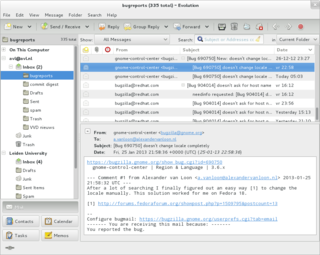Related Research Articles

Electronic mail is a method of exchanging messages ("mail") between people using electronic devices. Email entered limited use in the 1960s, but users could only send to users of the same computer, and some early email systems required the author and the recipient to both be online simultaneously, similar to instant messaging. Ray Tomlinson is credited as the inventor of email; in 1971, he developed the first system able to send mail between users on different hosts across the ARPANET, using the @ sign to link the user name with a destination server. By the mid-1970s, this was the form recognized as email.
In computing, the Internet Message Access Protocol (IMAP) is an Internet standard protocol used by email clients to retrieve email messages from a mail server over a TCP/IP connection. IMAP is defined by RFC 3501.
The Simple Mail Transfer Protocol (SMTP) is a communication protocol for electronic mail transmission. As an Internet standard, SMTP was first defined in 1982 by RFC 821, and updated in 2008 by RFC 5321 to Extended SMTP additions, which is the protocol variety in widespread use today. Mail servers and other message transfer agents use SMTP to send and receive mail messages. SMTP servers commonly use the Transmission Control Protocol on port number 25.

An email client, email reader or more formally mail user agent (MUA) is a computer program used to access and manage a user's email.

GNOME Evolution is the official personal information manager for GNOME. It has been an official part of GNOME since Evolution 2.0 was included with the GNOME 2.8 release in September 2004. It combines e-mail, address book, calendar, task list and note-taking features. Its user interface and functionality is similar to Microsoft Outlook. Evolution is free software licensed under the terms of the GNU Lesser General Public License (LGPL).
X.400 is a suite of ITU-T Recommendations that defines the ITU-T Message Handling System (MHS).
Microsoft Exchange Server is a mail server and calendaring server developed by Microsoft. It runs exclusively on Windows Server operating systems.

Pegasus Mail is a proprietary email client developed by David Harris. It was originally released in 1990 for internal and external mail on NetWare networks with MS-DOS and later Apple Macintosh clients. It was subsequently ported to Microsoft Windows, which is now the only platform actively supported. Previously freeware, Pegasus Mail is now donationware.
M+NetMail is an ISP-grade E-mail package by Messaging Architects. It is designed to deliver scalable messaging and calendaring services, using Internet-standard protocols, across a large enterprise, or to a large group of users who are not particularly associated. The original name for the product, when owned by Novell, was Novell Internet Messaging System (NIMS). Messaging Architects showcased NetMail on its MyRealBox website, this service was discontinued on June 1, 2011.
Extended SMTP (ESMTP), sometimes referred to as Enhanced SMTP, is a definition of protocol extensions to the Simple Mail Transfer Protocol (SMTP) standard. ESMTP was defined in November 1995 in IETF publication RFC 1869 which established a general structure for all existing and future extensions.

SquirrelMail was a project that aim to provides both a web-based email client and a proxy server for the IMAP protocol.
Microsoft Mail was the name given to several early Microsoft e-mail products for local area networks, primarily two architectures: one for Macintosh networks, and one for PC architecture-based LANs. All were eventually replaced by the Exchange and Outlook product lines.
Mercury Mail Transport System is a standards-compliant mail server developed by David Harris, who also develops the Pegasus Mail client.
cc:Mail was a store-and-forward LAN-based email system originally developed on Microsoft's MS-DOS platform by Concentric Systems, Inc. in the 1980s. The company, founded by Robert Plummer, Hubert Lipinski, and Michael Palmer, later changed its name to PCC Systems, Inc., and then to cc:Mail, Inc. At the height of its popularity, cc:Mail had about 14 million users, and won various awards for being the top email software package of the mid-1990s.
Opportunistic TLS refers to extensions in plain text communication protocols, which offer a way to upgrade a plain text connection to an encrypted connection instead of using a separate port for encrypted communication. Several protocols use a command named "STARTTLS" for this purpose. It is primarily intended as a countermeasure to passive monitoring.
Para Mail was a proprietary, electronic mail client that was developed and maintained by Kris Land and his team. It was originally released in 1985 for MS-DOS, but was subsequently ported to Microsoft Windows. A version for Apple Macintosh also used to be available.
Exchange ActiveSync is a proprietary protocol designed for the synchronization of email, contacts, calendar, tasks, and notes from a messaging server to a smartphone or other mobile devices. The protocol also provides mobile device management and policy controls. The protocol is based on XML. The mobile device communicates over HTTP or HTTPS.

GroupWise is a messaging and collaboration platform from Micro Focus that supports email, calendaring, personal information management, instant messaging, and document management. The GroupWise platform consists of desktop client software, which is available for Windows, Mac OS X, and Linux, and the server software, which is supported on Windows Server and Linux.

Zentyal is an open source email and groupware solution based on Ubuntu Linux.
The JSON Meta Application Protocol (JMAP) is an Internet protocol for handling the submission and access/synchronization of email, developed as an alternative to IMAP/SMTP and proprietary email APIs that only work with Gmail and Outlook.
References
Para-Mail from Paradox Development Corporation was the first email package to be brought into Novell and MHS. Paradox Development Corporation introduced Para-Mail version 2.0 with Novell at Comdex 1986.
- ↑ "MHS: Correct Addressing format to DaVinci Email via MHS". Microsoft Support Knowledge Base. Retrieved 2007-01-15.
- ↑ "...offers improved performance, greater reliability and much more flexibility in everything from communications hardware to scheduling..." Archived 2014-03-30 at the Wayback Machine , 03/07/94, Mark Gibbs, Network World